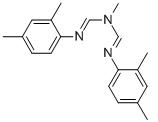Amitraz 双甲脒
Introduction: Amitraz is a triazapentadiene compound, a member of the amidine chemical family. It is an insecticide and acaricide used to control red spider mites, leaf miners, scale insects, and aphids. On cotton it is used to control bollworms, white fly, and leaf worms. On animals it is used to control ticks, mites, lice and other animal pests.The EPA classifies Amitraz as Class III - slightly toxic. However, products containing it bear the SIGNAL WORD: CAUTION。
Common name: Amitraz
Another name: Mitac; Taktic; Triazid; Azaform; Mitaban; Acarac; BAAM; Azadieno; Ectodex; Edrizar; Amitraz estrella; Fumilat A; Amitraze; Bipin; etc.
Chemical name: N,N'-[(methylimino)dimethylidyne]di-2,4-xylidine
Empirical formula: C19H23N3
Structural formula:

Mol. Weight: 293.41 g/mol
CAS No.: 33089-61-1
Specifications
Leading Amitraz supplier
Amitraz 98% TC
Amitraz 200 g/l EC
Packing:
BULK PACKING
Powder: 25kg/Bag, 25kg/Drum, 50kg/Drum etc.
Liquid: 200L/Drum, 20L/Drum, 10L/Drum etc.
SMALL PACKING
Powder: 1kg/Alu bag, 500g/Alu bag, 200g/Alu bag, 100g/Alu bag, 50g/Alu bag, 15g/Alu bag etc.
Liquid: 5L/Drum, 1L/Bottle, 500ml/Bottle, 250ml/Bottle, 100ml/Bottle, 50ml/Bottle etc.
Customerized packing label
Amitraz FAO standard
Professional registration
HAZARDS IDENTIFICATION
Hazard statement(s)
H302: Harmful if swallowed.
H311: Toxic in contact with skin.
H317: May cause an allergic skin reaction.
H373: Causes damage to organs through prolonged or repeated exposure.
H400: Very toxic to aquatic life.
H410: Very toxic to aquatic life with long lasting effects.
Precautionary statement(s)
P301 + P312: IF SWALLOWED: Call a POISON CENTER or doctor/ physician if you feel unwell.
P302 + P352: IF ON SKIN: Wash with plenty of soap and water.
P333 + P313: If skin irritation or rash occurs: Get medical advice/ attention.
P260: Do not breathe dust/fume/gas/mist/vapors/spray.
P280: Wear protective gloves/ eye protection/ face protection.
P264: Wash face, hands and any exposed skin thoroughly after handling.
P270: Do not eat, drink or smoke when using this product.
P330: Rinse mouth.
P273: Avoid release to the environment.
P391: Collect spillage.
P501: Dispose of contents/ container to an approved waste disposal plant.
P272: Contaminated work clothing should not be allowed out of the workplace.
P363: Wash contaminated clothing before reuse.
MAMMALIAN TOXICOLOGY
Acute toxicity: 1) Acute oral LD50 for rats is 800 mg/kg. 2) Acute dermal LD50 for rats is >200 mg/kg. 3) Acute inhalation toxicity LC50 (4 h) for rats is 65.0 mg/l. 4) Skin irritation: Non-irritating to skin (rabbits). 5) Eye irritation: Non-irritating to eyes (rabbits). 6) Skin sensitization for guinea pig: Not a skin sensitiser.
NOEL: NOEL (2 y) for rats is 2.5 mg/kg, (2 y) for mice is 2.3 mg/kg, (2 y) for dogs is 0.25 mg/kg. Other Not carcinogenic, not genotoxic.
ADI (JMPR) 0-0.01 mg/kg b.w.[1998]
Classification:
WHO Classification: II (Moderately hazardous)
EC Risk Classification: Xn - Harmful: R22, R43, R48/22; N - Dangerous for the environment: R50, R53.
US EPA Classification (formulation): III (Caution - Slightly toxic)
ECOTOXICOLOGY
Effect on birds: Acute oral LD50 for Bobwhite quail is 788 mg/kg. Effect on fish: Acute LC50 (96 h) for Rainbow trout is 0.74 mg/l. Effects on aquatic invertebrates: Acute EC50 (48 h) for Daphnia magna is 0.035 mg/l. Effects on algae: Acute EC50 (72 h) for Raphidocelis subcapitata is 12 mg/l. Effects on bees: Contact acute (48 h) LD50 is 50 μg/bee. Effects on earthworms: Acute 14 day LC50 is 1000 mg/kg.
ENVIRONMENTAL FATE
Breakdown of Chemical in Soil: Amitraz is broken down rapidly in soil containing oxygen. The half- life in soil, the amount of time needed for the chemical to degrade to half its original concentration, is less than one day. Degradation occurs more rapidly in acidic soils than in alkaline or neutral soils. Breakdown of Chemical in Vegetation: Reports indicate that amitraz may cause crop injury to young peppers and pears during high temperature conditions
| 






